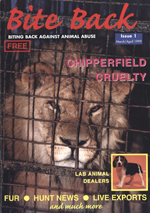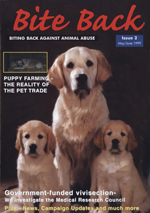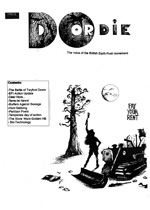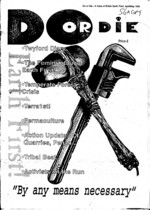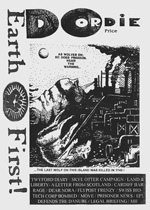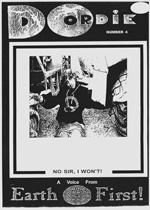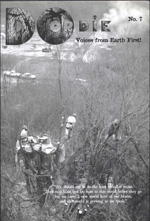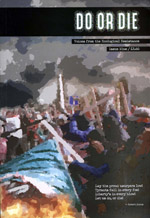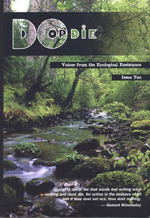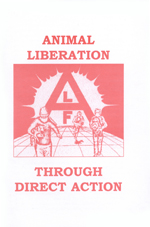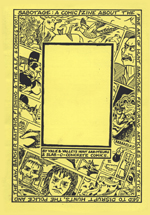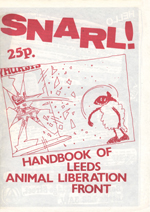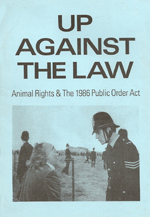The Archives
-
Periodicals
Bite Back (U.K.) #1&2
04.07.15 | PermalinkBite Back – Issues 1-2 (1999, Bristol, England)
One of at least four publications to share the same moniker, this version of Bite Back came into being at the turn of the century. Glossy, full magazine sized, and free, Bite Back was a wonderful tool for reporting on the exciting campaigns of its era. Anyone interested in pressure campaigning will enjoy the brief articles, updates, and images from Hillgrove, Shamrock, Regal Rabbits, and Huntingdon Death Sciences.
We have very little information about this publication and do not know if there were subsequent issues. If you have more information please contact us HERE.
…
-
Earth First! Journal, Periodicals
Earth First! Journal 1987
11.03.14 | PermalinkEarth First! Journal (1987, Issue #1-8. Tucson, AZ.)
Writing about Earth First! during its 1980s heyday is a delicate matter. I want to celebrate their best tendencies without ignoring their worst. 1987 is a particularly difficult year to do the former.
After the publication of an article called “Alien Nation” called for a closing of the US border to immigrants (strictly for environmental reasons we are told, not because EF! icon Ed Abbey advocated the use of the term “wetback” and used “cultural chauvinist” to describe his particular brand of racism) anarchists challenged the authors at a gathering in late 1986. So began a years worth of letters to the editor defending the piece. More than one missive in this volume praised AIDS as a positive development for the environment, and various racist, classist, and macho arguments bleed into many of the pages. Given these facts it feels callous to point to the positives that this volume also contains, so I will leave it to our readers to discover those for themselves.
Earth First! is a complex non-organization that has gone through many incarnations, changes in direction, and has never had a political consensus on any issue during the entirety of its history. If I can point out one mitigating factor for these eight issues it is that at least some Earth First!ers fought back in print and in person against the most backwards opinions of their peers, something still needed in the movement today.
…
-
Do or Die, Most Popular, Periodicals
Do or Die – The Complete Set!
04.09.14 | PermalinkDo Or Die #1-10 (1993-2003, Brighton, England.)
A few years ago a friend asked me if I had a complete set of Do or Die, the British Earth First! publication that inspired and incited eco-warriors throughout the 1990s and early 2000s. At one time I did have them, but they had long since been stolen by a Joint Terrorism Task Force.
After a brief discussion, we decided that Do or Die was too important to fade into obscurity. We began tracking down each issue, and decided that while we were at it we ought to archive some other publications as well. That effort is how this web site began, and now, thanks to 56a infoshop of South London and Tim @ NEDS Northampton, we can finally share the very rare issue #2. This completes our collection, and our original mission as well.
When read as a set, Do or Die is a chronicle of people from across the globe counter-striking capitalism, ecocide, and the state. Each issue is better than the last, but more importantly, each page is a spark licking at the fuse of the bomb that is your heart. Once lit, you’ll know that these pages are not mere history, but a reminder that we can explode onto the world stage like the fighters before us have. Do or die, now is the time to rise.
…
-
One-off publications
Animal Liberation Through Direct Action
03.28.14 | PermalinkAnimal Liberation Through Direct Action – (Date of publication unknown, likely 1998. Country of origin unknown, likely England)
Animal Liberation Through Direct Action was one of the better primers available in the 1990s. Designed for activists who had never before participated in illegal actions, the pamphlet discusses the basic security, surveillance, and planning necessary to carry out liberations and economic sabotage. It also includes a brief history of the movement, a first hand account of a mink farm raid, and statements from various ALF cells.
…
-
One-off publications
Sabotage : A Comic / Zine About The Fine Art Of Hunt Sabotage
02.15.14 | PermalinkSabotage : A Comic / Zine About The Fine Art Of Hunt Sabotage (1992 – Cardiff, UK)
Produced by the Vale and Valleys Hunt Sabs, this short zine provides exactly what the title suggests. The interior has articles and comics from a wide cross section of saboteur subcultures, from crusties to older folks in white tennis shoes. The quality of the content is all over the map as well, but still makes for an interesting look at sabbing culture and technique in the early 1990s.
…
-
One-off publications
The Animal Liberation Primer
01.28.14 | PermalinkThe Animal Liberation Primer (publishing date unknown, location likely the United States)
Containing material mostly culled from other similarly named primers, this is a short how-to guide for small scale property damage, arson*, and liberations. It contains a basic run down of security measures, mental preparation, and history of the Animal Liberation Front. Although it was surely a good resource in its time, its value as a primer has diminished with the advent of new security technologies, legislation, and state-surveillance. Anyone looking to undertake direct action would do well to find a modern source of instruction.
*The United States government fears a public empowered with the means to confront the excesses of their corporate masters, and as such has banned the distribution of literature containing instructions to build destructive devices. You can still purchase a shotgun at Walmart, or a bomb manual on Amazon, but we must censor all instructions here on our site. We apologize to our readers for the impact this has on the completeness of our archive.
…
-
One-off publications
SNARL! Handbook of the Leeds A.L.F.
11.12.13 | PermalinkSNARL! Handbook Of Leeds ALF (1985. Leeds, England)
One of the great things about punk music is also one of the worst things about it: anyone can do it. On the one hand this encourages kids to destroy the adulation of rockstars and to make music (as well as zines, clothes, art, etc) themselves. That accessibility has brought us the voices of people we never would have otherwise heard, which is wonderful. On the other hand, punk doesn’t exist in a vacuum, it came into being in a culture afflicted with bias and brutality, patriarchy, capitalism, and so on. Those elements are ingrained in many of the creators of punk and are, at times, reflected in the works they produce. Those messages are then carried on to those who consume that media.
It isn’t hard to make the leap from an analysis of punk to an analysis of leaderless resistance. Without a hierarchy or organized recruiting mechanism, the A.L.F. has often spread through the same means as punk rock- DIY media, the passion and anger of youth, and at times, sensationalized mainstream media stories. People have heard the call and picked and up the banner, acting on their own initiative to make change. The downside, of course, is that without a training component that goes beyond a few words in a zine about security culture, these newly active saboteurs aren’t always left with the skill set needed to safely or effectively undertake underground actions. They may end up making their own publications which repeat the mistakes of the ones they first read, and these will be passed on to the consumers of that media.
If I were 16 years old and living in Leeds in 1985, I would have loved SNARL. It speaks from a place of youthful (and righteous) rebelliousness, and although the tone can be a little dogmatic, nearly everything else about the “handbook” is just plain cool. I laughed out loud to see license plates, makes and models of undercover police vehicles listed, and was encouraged to see the inclusion of human liberation struggles. That said, the young folks who made this zine were reproducing some of the worst aspects of other publications from the era as far as security and theatrical militancy goes.
SNARL is an interesting product of it’s time, written and distributed by well meaning, hard-fighting folks who no doubt had the best interest of non-humans in their hearts. That said, I hope readers at the time were cautious in following the advice it contained, because much of it was outright dangerous. Looking at the prisoner listings from this period, that doesn’t seem to be the case.
…
-
One-off publications
Up Against The Law
09.16.13 | PermalinkUp Against The Law (1987 – London, England)
Long before the Animal Enterprise Terrorism Act or the advent of Ag-Gag laws, western governments were using other means to protect the profits of animal abusers. Through methods legislative and extra-legal, the British government was particularly skilled in disrupting the efforts of animal liberationists. By the late 1980s these attacks had become so commonplace and effective that J.J. Roberts (the collective pen name of John Page and Jane Holgate) of ARC Print (Publisher of the excellent Against All Odds) wrote Up Against the Law as an effort to give activists knowledge of repressive legislation and a means to fight back.
Up Against the Law is crucial reading for those who want to understand the history of public order laws, their use against activists, and how our movement has coped with past attacks on our abilities to protest.
…
-
Most Popular, No Compromise, Periodicals
No Compromise: The Final Two Issues
05.13.13 | PermalinkNo Compromise #29-30 (2006. Santa Cruz / San Francisco, CA)
The early days of my activism were so exciting. After a lifetime of feeling powerless I suddenly discovered that there was a community dedicated to fighting the good fight. Its members were in every major city and many smaller ones, and sometimes not living in any city at all, but in trees and encampments. The people involved were empowered to act for themselves in order to create a better world, and had abandoned all the false hope of political parties and their dead politics. Words meant little, action was what counted, and the sky was the limit. The internet was not yet in wide use, and thank goodness! That meant that we met each other in conference rooms, in squats, on the streets, and sometimes on the pages of No Compromise magazine.
No Compromise shaped who I am today. Each new issue contained articles that helped me and thousands of others to evolve our own style of resistance, and as our experience grew we were able to share our stories in the pages of the magazine.
After 30 issues, the steering committee of No Compromise decided to stop publishing in 2006. Their decision could not have come at a worse time. With the SHAC website and newsletter killed by the convictions of the SHAC 7, Bite Back being published only sporadically and with a limited focus, and the Earth First! Journal mired in its “Confronting Oppression Within” drama, the sudden absence of No Compromise meant that the primary sources for radical animal liberation news, opinion, and strategy were the twin sewers of online social networks and the North American Animal Liberation Press Office. These were dark times for our movement, and we are only just beginning to recover.
The final issues of No Compromise were the best of the series, though! I was in prison when issue 30 was released, and it felt electric in my hands. I read it over and over, alternately laughing and crying. As I was putting this post together I decided to pull out that print copy. It gave me the same sense of awe I had when I read those first issues. More than that, it reminded me that there is still a community of people capable of changing the world through compassionate direct action and mutual aid. And you know what? We are going to win!
KEEP FIGHTING,
Josh Harper(The complete set of all past issues of No Compromise can be found HERE)
…
-
Do or Die, Periodicals
Do or Die #9
03.27.13 | PermalinkDo or Die #9 (2000, Brighton, England.)
We always write the same thing when we post an issue of Do or Die, so this time we will spare you the superlatives. This issue has worldwide ecological news, human freedom struggles, non-human direct action, and a radical history of football alongside a little bit of humor and many inspiring images. A must read, so click below and get to it!
…
